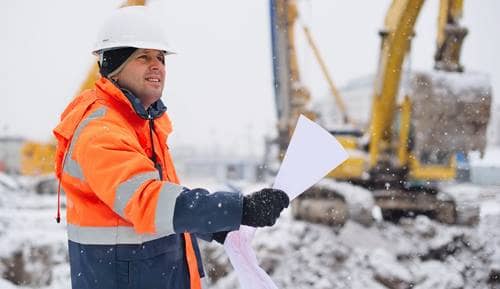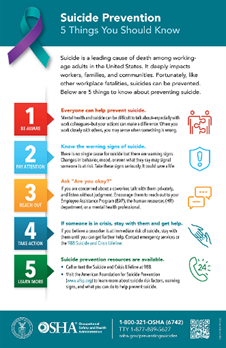Safety news

The U.S. Department of Labor (DOL) notes that what constitutes extreme cold and its effects can vary across the country. Because a cold environment forces the body to work harder to maintain its temperature, as temperatures drop below normal and wind speeds increase, heat can leave the body more rapidly.
Wind chill is the temperature felt by the body when air temperature and wind speed are combined. For example, when the air temperature is 40°F, and the wind speed is 35 mph, the effect on exposed skin is like an air temperature of 28°F.
Cold stress can occur when the skin temperature goes down and the internal body temperature (core temperature) drops. This can lead to serious health problems and cause tissue damage and possibly death. Exposed workers are vulnerable to hypothermia, frostbite, and trench foot.
Some risk factors that contribute to cold stress are:
- Wetness and dampness, dressing improperly, and exhaustion
- Predisposing health conditions such as hypertension, hypothyroidism, and diabetes
- Poor physical conditioning
The DOL and Occupation Safety and Health Administration (OSHA) recommends that employees working in frigid temperatures avoid alcohol, smoking, and some medications to help minimize risks.
The best way to avoid cold stress is by wearing proper clothing. The type of fabric makes a difference as well. For example, cotton loses its insulation value when it becomes wet, while wool, silk, and most synthetics retain their insulation even when wet.
Here are some clothing tips for workers in cold environments:
- For better insulation wear at least three layers of clothing: An inner layer of wool, silk, or synthetic to wick moisture away from the body; a middle layer of wool or synthetic to provide insulation even when wet; and an outer wind and rain protection layer that allows some ventilation to prevent overheating. Avoid tight fitting clothing.
- Wear a hat or hood to help keep the entire body warm. Hats reduce the amount of body heat that escapes from the head.
- Wear insulated boots or other appropriate footwear.
- Keep extra clothing (including underwear) handy in case clothing gets wet.
- Do not underestimate the wetting effects of perspiration. Venting of the body’s sweat and heat can be more important than protection from rain or snow, according to the DOL.
OSHA also issues guidelines. For example, because it is easy to become dehydrated in cold weather, employers can provide warm sweetened liquids to workers. Additionally:
- If possible, schedule heavy work for the warmer part of the day. Assign workers to tasks in pairs so that they can monitor each other for signs of cold stress.
- Allow workers to interrupt their work if they are extremely uncomfortable.
- Give workers frequent breaks in warm areas.
- Acclimatize new workers and those returning after time away from work by gradually increasing their workload. Also allow more frequent breaks in warm areas to help them build tolerance for working in the cold environment.
Source: https://www.osha.gov/emergency-preparedness/guides/cold-stress
Falls account for most construction deaths
- Between 300 to 400 construction workers fall to their deaths, most often while working at heights on roofs, ladders, and scaffolds, according to OSHA.
- In 2020, out of 1,034 falls that resulted in death in the construction industry, 353 were due to falls from a height to a lower level.
- Most fatal falls happen to roof and finishing contractors in residential construction.
- Residential roofers are more than 10 times more likely to die from a fall than other construction workers.
Source: https://www.cdc.gov/niosh/construction/pdfs/highest-risks_16sn-508.pdf

Natural disasters and severe weather including hurricanes, tornadoes, extreme heat, and flooding, can have major impacts on communities and families.
Planning to maintain and protect your health in a disaster or emergency is an important but often overlooked part of the preparedness process. Involve your entire family in planning and practicing how to stay healthy, informed, calm, and connected during an emergency.
If you live in an area of the country prone to severe weather events or if you or a loved one have health conditions that may be complicated by weather conditions, staying up to date on safety recommendations can help you stay healthy and safe.
Explore CDC’s pages below for more information about how to be ready if severe weather affects your area.
- Extreme heat
- Floods
- Hurricanes
- Tornadoes
- Other natural disasters and severe weather
Source: https://www.cdc.gov/disasters/index.html
Tips on preventing eyestrain
Rest the muscles of your eyes by occasionally focusing on a distant object away from your monitor.
Since the average American spends over seven hours looking at a screen each day, according to a June 8, 2021, report from DataReportal, here are some tips from The American Industrial Hygiene Association on how to avoid eyestrain.
In an overall report on ergonomics, the organization identified several problem areas and possible corrections for eyestrain, including:
- Glare
- Move or shield the light source.
- Move the monitor.
- Change the monitor’s angle.
- Apply a good quality glare filter to the monitor.
- When correcting for glare, don’t create other problems. For instance, if you move your monitor, don’t put it in a place that will produce neck strain. The monitor should be directly in front of you.
- When possible, place your monitor at a right angle with the window.
Lighting levels
- Following the preceding recommendations, adjust your screen position and lighting sources (lamps, etc.) to achieve best results.
- Work with a light screen background (dark type or images on white or pale background)—you will find it is easier on your eyes.
- Rest the muscles of your eyes by occasionally focusing on a distant object away from your monitor.
- When using a laptop, look into the distance more frequently. A laptop monitor will probably not have the best placement, since it is attached to the keyboard.
- If you are using a laptop at your primary workstation, a docking station with an external keyboard and mouse should be used. An external monitor, or display, should also be considered.
Readability of screen and document
- Place monitors directly in front of you and documents to the immediate right or left, at the same distance.
- Upgrade or replace monitors with poor resolution or flicker.
- Adjust your monitor’s font size.
- If you wear glasses, consider getting full-frame reading glasses prescribed for the working distance of your monitor (typically, 15 to 30 inches/38 to 76 cm). These will allow you to place the monitor correctly and see well without stressing your posture.
- Place the monitor so the top of the screen is at your line of sight. If you wear bifocals, the top of the screen should be slightly below your line of sight.
- Don't skip visits to the eye doctor. Eyestrain could indicate a problem with your vision beyond the use of a computer monitor.

According to the National Institute of Mental Health, nearly one in five adults are living with a mental health condition, such as anxiety, depression, or post-traumatic stress. In June 2020, the Center for Disease Control found that 40% of US adults were struggling with mental health or substance abuse and 11% seriously considered suicide. Work-related stress can have an impact on mental health and, without proper support, could lead to substance abuse and even suicide. Workers in the construction industry are generally at a higher risk for suicide due to work-related stress factors including seasonal/temporary employment, demanding work schedules, and serious injuries, which are sometimes treated with opioids. Not addressing the underlying stressors or injuries can exacerbate mental health symptoms and may increase the risk of substance abuse or even suicide.
As an employer, there are many changes that can be made to decrease worker fatigue. Employers can change schedules and staffing to ensure every worker has time to rest. They can also make physical changes such as changing lights to “increase alertness,” OSHA says.
- Research estimates that 13% of workplace injuries can be attributed to fatigue, and 43% of American workers admit they may be too tired to function safely at work.
- Employers can reduce the risk of fatigue and assist employees by rotating shift schedules or frequent night shift schedules that face high risks for fatigue.
- Employers should avoid assigning permanent night shift schedules, avoid long shift lengths (no longer than 12 hours), and provide adequate time to recover between shifts.
- Employees should be given more input into their schedules and given frequent breaks within shift obligations.
Suicide prevention: new resource from OSHA
According to the National Safety Council (NSC), about 13% of injuries in the workplace involve fatigue. Reducing the potential for worker fatigue is essential for everyone involved. There are steps employees and employers can follow to mitigate the risks associated with fatigue.
When you work closely with someone, you may sense when something is wrong. If you are concerned about a coworker, talk with them privately, and listen without judgment. Encourage them to get help. If someone is in crisis, stay with them and get help. If you believe a coworker is at immediate risk of suicide, stay with them until you can get further help. Contact emergency services or call 988 for the Suicide and Crisis Lifeline.

Additional information is available from the following: https://www.osha.gov/preventingsuicides
Source: https://www.nimh.nih.gov/health/topics/suicide-prevention
Workplace violence: a universal threat
Did you know each year, 761,000 workers experience some form of physical assault in the workplace (National Crime Victimization Survey, 2021)? Behind transportation incidents, violence is the top cause of death for women in the workplace (Bureau of Labor Statistics (BLS), 2021). In the past decade, workplace violence has taken the lives of 788 US workers per year, on average (BLS, 2011-2021).
NIOSH estimates the annual nationwide economic cost of workplace violence is nearly $121b.
Employee productivity is estimated to decrease up to 50% in the 6 to 18 weeks following an incident of violence, while turnover can increase to upwards of 30% to 40% (National Institute for the Prevention of Workplace Violence, n.d.).
Click here to view a fact sheet for additional information.
Source: National Safety Council (NSC)
OSHA outreach training
If you’d like information on OSHA’s Outreach Training program just go to the Outreach Training (10-Hour or 30-Hour Cards) webpage.
The Outreach Trainers list will help you find OSHA-authorized trainers who conduct 10- and 30-hour Outreach Training classes in construction, general industry, maritime, or disaster site work. The Department of Labor/Occupational Safety and Health Administration lists only those trainers who have requested that their contact information be made public. Trainers who want to be listed with OSHA’s Outreach Training Program as an authorized trainer should contact their Authorizing Training Organization (OTI Education Center).
Inclusion on this list does not imply any endorsement by OSHA.
OSHA has updated the Outreach Training webpage to include a search function that allows people to “search by language.” Some example languages include French, Mandarin, Samoan and Farsi. You can find that search function at Find Classroom Trainers (all languages).
Source: Occupational Health and Safety Administration (OSHA)
This "document” is intended for general information purposes and should not be construed as advice or opinions on any specific facts or circumstances. The content of this document is made available on an “as is” basis, without warranty of any kind. This document cannot be assumed to contain every acceptable safety and compliance procedure or that additional procedures might not be appropriate under the circumstances. Markel does not guarantee that this information is or can be relied on for compliance with any law or regulation, assurance against preventable losses, or freedom from legal liability. This publication is not intended to be legal, underwriting, or any other type of professional or technical advice. Persons requiring advice should consult an independent adviser or trained professional. Markel does not guarantee any particular outcome and makes no commitment to update any information herein, or remove any items that are no longer accurate or complete. Furthermore, Markel does not assume any liability to any person or organization for loss or damage caused by or resulting from any reliance placed on this content.
Markel® is a registered trademark of Markel Group Inc.
© 2023 Markel Service, Incorporated. All rights reserved.
